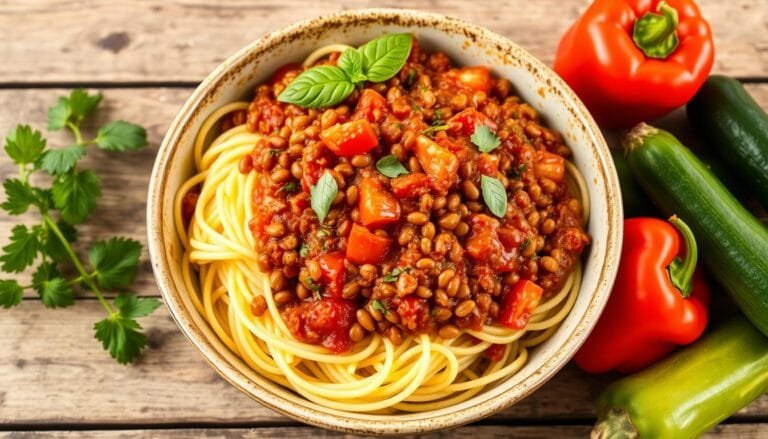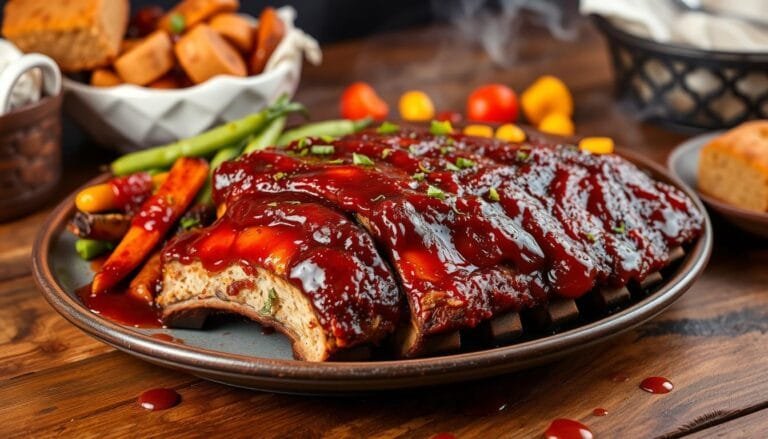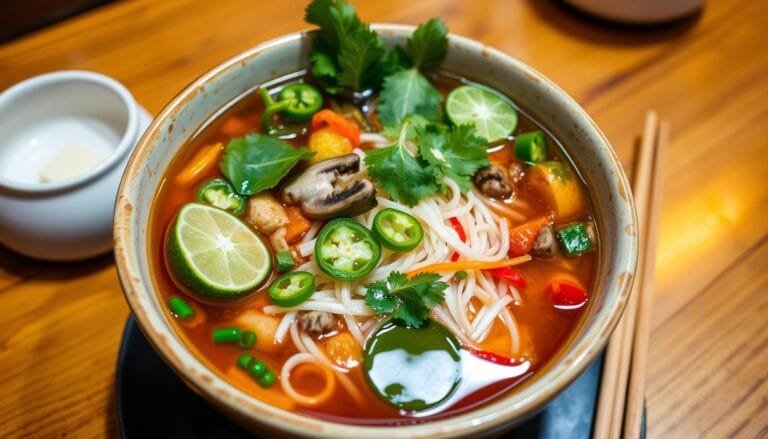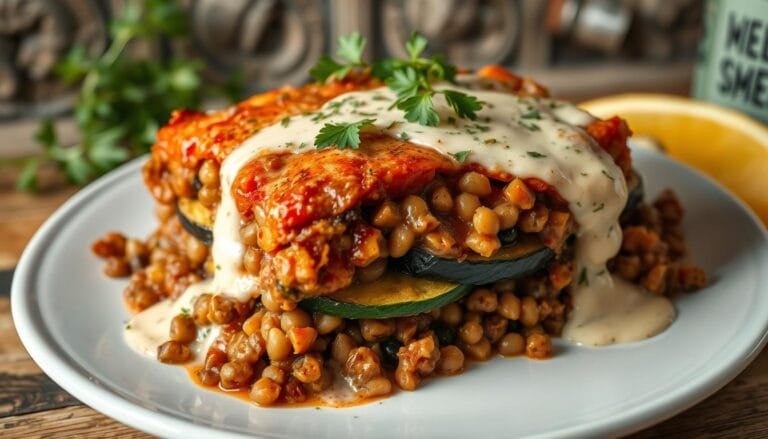I love baking and making homemade vegan croissants. They are buttery, flaky, and fluffy. They’re a great vegan breakfast treat that you can enjoy without feeling guilty. The recipe for vegan croissants was first shared in a popular YouTube video in 2017. It has become a favorite among home bakers.
Making vegan croissants might seem hard at first. But, the process can be broken down into easy steps. The recipe lets you split the preparation over 2 or 3 days. This makes it easy for home cooks with busy lives.
What makes these vegan croissants special is using bread flour instead of all-purpose flour. Bread flour has more gluten, which helps the dough rise better. The recipe also suggests using vegan butter brands like Country Crock Plant Butter with Avocado Oil, Trader Joe’s Vegan Butter, and Miyoko’s Creamery cultured vegan butter. These are key for getting the flaky texture.
With the right techniques and care, you can make delicious vegan croissants at home. Whether you’re an experienced baker or new to plant-based pastries, this recipe will wow your family and friends. It’s a wonderful addition to your breakfast menu.
Understanding the Art of Vegan Croissant Making
Making vegan croissants is all about mastering plant-based baking and pastry science. Unlike regular croissants, which use dairy butter, vegan ones use dairy-free alternatives. This helps achieve a flaky and rich texture.
The Science Behind Flaky Vegan Pastries
The secret to flaky vegan croissants is the lamination process. It involves folding and rolling dough and plant-based butter together. This creates layers that puff up in the oven, giving the croissants their flaky texture.
Key Differences from Traditional Croissants
While vegan croissants use similar techniques, there are differences. They use plant-based butter instead of regular butter. Also, plant-based milks like soy or almond milk replace dairy milk.
Benefits of Plant-Based Alternatives
Switching to plant-based ingredients makes vegan croissants more accessible. They are cholesterol-free and great for those with dairy allergies or who follow a vegan diet. Plus, they can be more tender and flaky than traditional croissants.
“Vegan croissants are a delightful way to enjoy a classic pastry while embracing a more sustainable and plant-based lifestyle.”
| Vegan Croissant Characteristics | Traditional Croissant | Vegan Croissant |
|---|---|---|
| Main Fat Ingredient | Dairy Butter | Plant-Based Butter |
| Milk Ingredient | Dairy Milk | Plant-Based Milk |
| Cholesterol Content | Cholesterol-Containing | Cholesterol-Free |
| Suitability for Dietary Restrictions | Not Suitable for Dairy Allergies or Vegans | Suitable for Dairy Allergies and Vegans |
| Texture | Flaky and Buttery | Flaky and Tender |
Essential Ingredients for Perfect Plant-based Croissants
Making vegan croissants starts with the right ingredients. Bread flour is best for its high gluten, giving the croissants structure and rise. Vegan butter sticks are key for that flaky, buttery taste we love.
For flavor, use active dry or instant yeast, a bit of sugar, and salt. Dairy-free milks like soy, almond, or oat milk are great for the liquid. These plant-based baking supplies are the base of a great vegan croissant.
Choosing the right vegan croissant ingredients is important. Miyoko’s or Earth Balance vegan butter is perfect for the lamination process. A vegan “egg” wash with maple syrup and soy milk adds a golden sheen.
With these dairy-free pastry components, you can make plant-based croissants as good as the real thing. A bit of practice and these ingredients will have you making delicious vegan croissants in no time!
Choosing the Right Vegan Butter for Lamination
Choosing the right vegan butter is key for flaky, buttery vegan croissants. The right butter makes all the difference in achieving perfect lamination. It also ensures a delicious plant-based breakfast treat. Let’s look at the best vegan butter brands for baking and important tips for temperature control and storage.
Best Vegan Butter Brands for Baking
For the best vegan croissant baking, try these top vegan butter brands:
- Country Crock Plant Butter with Avocado – It stands up well to high-heat baking without separating or burning.
- Trader Joe’s Vegan Butter (block version) – It has a rich, creamy texture that laminates beautifully.
- Miyoko’s Creamery cultured vegan butter – It has a tangy, European-style flavor that enhances baked goods.
Temperature Control Tips
Temperature control is key when using vegan butter for lamination. The butter needs to be cold enough to keep its structure but also pliable for folding. Aim for a temperature that’s chilled but not too hard for the best results.
Storage and Handling
Store vegan butter in the fridge to keep it fresh. Handle it as little as possible to prevent it from softening. Keep an eye on the temperature and adjust your techniques for perfect lamination.

“The right vegan butter can make all the difference in achieving the perfect dairy-free lamination and delivering a delightful plant-based breakfast treat.”
Mastering the Lamination Process
Making the perfect vegan croissant needs a deep understanding of lamination. Lamination is folding butter into dough to create flaky layers. As a pro vegan baker, I’ve perfected this skill and I’m here to share it with you.
The secret to great vegan dough lamination is the right butter temperature and consistency. The butter should have 82-86% fat and be between 52-61°F (11-16°C) during lamination.
It’s important to keep the plant-based pastry folding cold. The dough should be between 36-43°F (2-6°C). This keeps the dairy-free croissant layers perfect and the butter from melting.
- Start by encasing a slab of chilled vegan butter in the dough, creating a butter-dough package.
- Perform a single turn, rolling the dough into a rectangle and folding it into thirds.
- Chill the dough for 20-30 minutes, allowing the gluten to relax and the butter to firm up.
- Repeat the rolling and folding process, this time doing a double turn, for a total of three folds.
- Chill the dough again before shaping and proofing your vegan croissants.
Mastering lamination is all about the right temperature and technique. With practice and focus, you’ll soon make vegan croissants that rival those from a bakery!
“The secret to a flaky, buttery vegan croissant lies in the precision of the lamination process.”
Step-by-Step Dough Preparation Techniques
Making the perfect vegan croissants starts with the dough. As a vegan baker, I’ve learned that flaky, golden croissants come from careful steps.
Mixing and Kneading Methods
I start by mixing 500g of flour, 7g of yeast, 60g of sugar, and 10g of salt in a big bowl. Then, I add 250ml of almond milk and 100g of chilled vegan butter. I knead for 5-7 minutes until it’s smooth and elastic.
Resting and Proofing Times
Next, I chill the dough for at least 12 hours. This step relaxes the gluten, making the dough perfect for croissants.
When shaping, I let it proof at 40°C (100°F) for 1-2 hours. This lets the yeast make the dough rise just right.
Temperature Control During Preparation
Keeping the right temperature is key for flaky croissants. I keep the vegan butter cold and the dough cool. This prevents it from getting too soft.
By following these steps, I make vegan croissants that are as light and delicious as the real thing. And they’re made without any animal products.
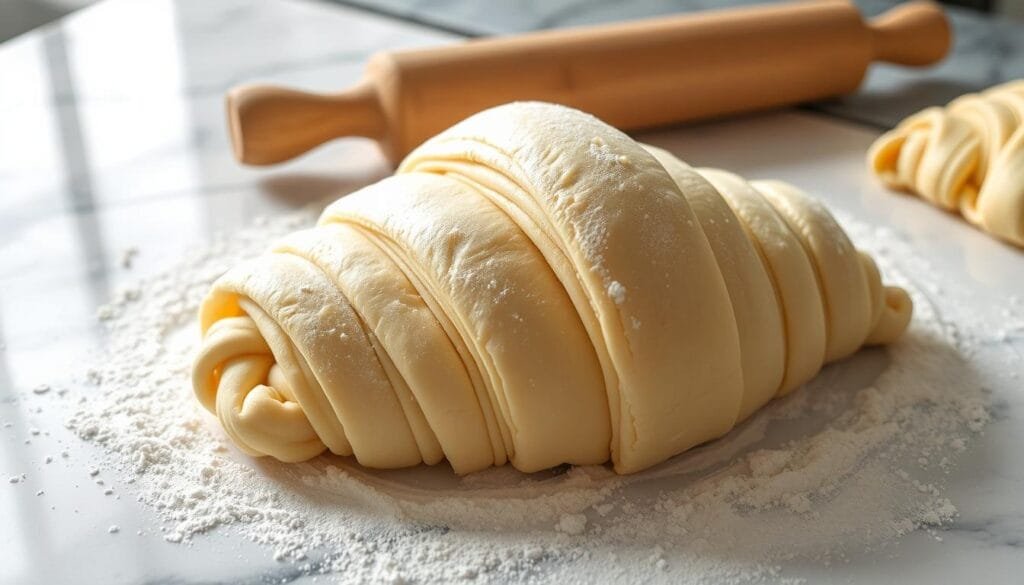
Shaping and Rolling Your Vegan Croissants
Making the perfect vegan croissant is an art that needs care and a soft touch. The way you shape and roll them is key to getting that flaky, crescent shape. Let’s explore how to do this right and make your plant-based pastry dreams come true.
Start by rolling out your vegan croissant dough into a rectangle, about 12 inches by 18 inches. Cut the dough into triangles, each 4 inches wide at the base. Make a small cut at the base of each triangle. This helps them shape into crescents as they bake.
- Roll each triangle tightly, starting from the base and moving towards the tip.
- Put the shaped dairy-free crescent rolls on a parchment-lined baking sheet, with the seam down.
- Let the croissants rise for 1 to 3 hours. This lets them get flaky and ready for baking.
Getting good at vegan croissant shaping takes practice, but it’s worth it. With patience and focus, you’ll soon be making perfectly shaped, golden plant-based pastries.
| Statistic | Value |
|---|---|
| Positive ratings for Super Easy Vegan Croissants recipe | 5 out of 22 people |
| Cooking time for vegan croissants recipe | 27 minutes |
| Total time for vegan croissants recipe | 37 minutes |
| Yield of the recipe | 12 croissants |
| Caloric content per croissant | 186 kcal |
“The key to perfect vegan croissants is in the shaping and rolling. Take your time, and you’ll be rewarded with flaky, buttery pastries that will impress even the most discerning plant-based palate.”
Professional Baking Tips for Golden-Brown Results
To get your vegan croissants just right, you need the right oven settings and baking tricks. As a pro, I’ve learned how to make plant-based pastries brown beautifully. It takes patience and a keen eye for detail.
Optimal Oven Settings
Start by heating your oven to 400°F (200°C). This high heat helps the dough rise and get that golden color. After 10 minutes, lower the temperature to 350°F (175°C). Keep baking for another 10-15 minutes. This slow drop in heat ensures the croissants cook evenly without getting too dark.
Achieving the Perfect Color and Texture
To make your vegan croissant baking even better, brush the tops with a mix of plant-based milk and maple syrup before baking. This trick caramelizes the sugars, giving you a crispy, golden crust.
| Step | Action |
|---|---|
| 1 | Preheat oven to 400°F (200°C) |
| 2 | Brush croissants with plant-based milk and maple syrup mixture |
| 3 | Bake for 10 minutes |
| 4 | Reduce heat to 350°F (175°C) and continue baking for 10-15 minutes |
By using these dairy-free baking techniques, you’ll make plant-based pastry that’s flaky and golden. Your taste buds and cravings will thank you.

Creative Filling and Serving Suggestions
Make your vegan croissant experience even better with these tasty filling and serving ideas. Plant-based pastries are super versatile. They open up a world of delicious dairy-free breakfast options.
Delightful Fillings
- Try vegan chocolate hazelnut spread or fruit preserves for a sweet treat.
- Enjoy the creaminess of almond or cashew butters for a rich breakfast.
- Go for savory with vegan ham and dairy-free cheese for a breakfast sandwich.
- Add sautéed mushrooms, caramelized onions, and herbs for a fresh twist.
- Try a Mediterranean vibe with vegan mozzarella, basil, and sun-dried tomatoes.
Innovative Serving Suggestions
- Turn your croissants into breakfast sandwiches with plant-based eggs and sausage.
- Set up a brunch with croissants, fresh fruit, compotes, and plant-based butters.
- Wow your guests with a croissant breakfast board filled with various toppings.
- Pair your croissants with vegan coffee or a refreshing juice for a classic combo.
- Get creative by using croissants in sweet or savory bread puddings, French toast casseroles, or as a croissant bread bowl.
Let your creativity shine with vegan croissants. Whether you stick to traditional or try new fillings, these pastries will make your dairy-free breakfasts unforgettable.
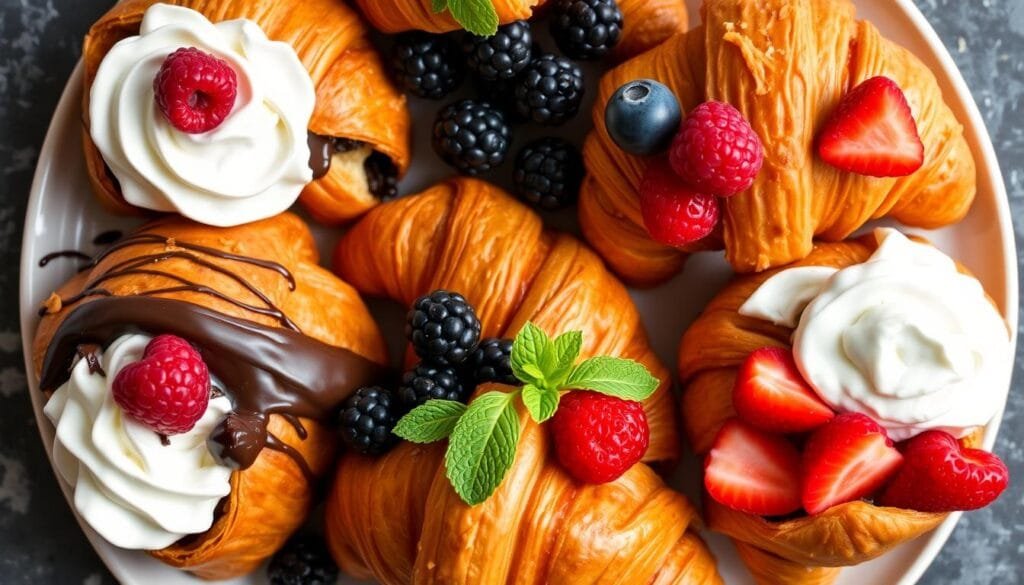
Make-Ahead and Storage Solutions
Don’t worry, making vegan croissants doesn’t have to be rushed. You can start by making the dough ahead of time. Just mix and knead it, then chill it in the fridge overnight. This step is key for getting those flaky layers right.
After baking, your croissants stay fresh for 2-3 days at room temperature. For longer storage, freeze them for up to 3 months. Just put the cooled croissants in an airtight container or bag and freeze.
Freezing and Reheating Methods
To thaw frozen croissants, leave them in the fridge overnight. Then, warm them up in a 350°F oven for 5 minutes. This makes them crisp and warm again. Don’t use the microwave, as it can make them soggy.
Maintaining Freshness
To keep your croissants fresh, store them in a paper bag or loosely covered. This prevents them from getting too soft or damp. Avoid airtight containers to avoid a soggy crust. With a bit of planning and the right storage, you can enjoy flaky, plant-based croissants whenever you want.
Troubleshooting Common Vegan Croissant Issues
Creating the perfect vegan croissant is a delicate task. But, with some troubleshooting, you can get great results at home. It’s all about solving common problems.
Dough that won’t rise is a big issue. It’s often due to old or inactive yeast. Always check the yeast’s expiration date and make sure it’s active. Also, proofing the dough in a warm place helps a lot.
Soggy croissants are another problem. This usually happens when the vegan butter gets too warm. If your dough gets too soft, put it back in the fridge or freezer. This helps keep the dough flaky.

